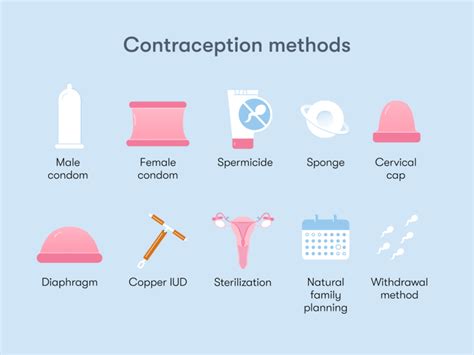Intro
Explore various birth control options, including hormonal methods, IUDs, and natural family planning, to find the best contraceptive method for your needs, considering effectiveness, safety, and convenience.
The topic of birth control has been a subject of discussion for decades, with various methods being developed to help individuals and couples plan their families effectively. With the advancement of medical technology and the increasing awareness of reproductive health, there are numerous birth control options available today. These options cater to different needs, preferences, and lifestyles, providing individuals with the freedom to choose the method that suits them best. The importance of birth control cannot be overstated, as it not only helps prevent unintended pregnancies but also reduces the risk of sexually transmitted infections (STIs) and promotes overall reproductive health.
The availability of various birth control methods has empowered individuals, particularly women, to take control of their reproductive health. This has led to significant improvements in education, career opportunities, and economic stability, ultimately contributing to a better quality of life. Moreover, the use of birth control has been shown to have numerous health benefits, including the reduction of menstrual cramps, regulation of menstrual cycles, and decreased risk of certain cancers. As the world continues to evolve, it is essential to stay informed about the latest birth control options and their benefits, allowing individuals to make informed decisions about their reproductive health.
The development of new birth control methods has been driven by the need for more effective, convenient, and user-friendly options. Today, individuals can choose from a wide range of methods, including hormonal and non-hormonal contraceptives, barrier methods, and sterilization. Each method has its unique characteristics, advantages, and disadvantages, making it crucial for individuals to understand their options and select the one that best fits their needs. By exploring the various birth control options available, individuals can make informed decisions about their reproductive health and take control of their future.
Introduction to Birth Control Methods

Types of Hormonal Contraceptives
Hormonal contraceptives are a popular choice among individuals due to their high effectiveness and convenience. These methods include: * Birth control pills: Oral contraceptives that contain estrogen and progesterone to regulate the menstrual cycle and prevent ovulation. * Patches: Transdermal patches that release hormones to prevent ovulation. * Rings: Vaginal rings that release hormones to prevent ovulation. * Injections: Depot injections that release hormones to prevent ovulation. * Implants: Small rods inserted under the skin that release hormones to prevent ovulation.Non-Hormonal Contraceptives

Barrier Methods
Barrier methods are a popular choice among individuals due to their ease of use and accessibility. These methods include: * Male condoms: Barrier devices that prevent sperm from reaching the egg. * Female condoms: Barrier devices that prevent sperm from reaching the egg. * Diaphragms: Barrier devices that cover the cervix to prevent sperm from reaching the egg. * Cervical caps: Barrier devices that cover the cervix to prevent sperm from reaching the egg.Sterilization Methods

Emergency Contraception
Emergency contraception is a vital option for individuals who have had unprotected sex or experienced contraceptive failure. These methods include: * Plan B: A hormonal emergency contraceptive that prevents ovulation. * Ella: A hormonal emergency contraceptive that prevents ovulation. * Copper IUD: A non-hormonal emergency contraceptive that prevents fertilization.Benefits of Birth Control

Risks and Side Effects
While birth control methods are generally safe and effective, they can have risks and side effects. These include: * Hormonal changes: Hormonal birth control methods can cause hormonal changes, leading to side effects such as mood swings and breast tenderness. * Blood clots: Hormonal birth control methods can increase the risk of blood clots, particularly in individuals with a history of clotting disorders. * Weight gain: Some birth control methods can cause weight gain, particularly in individuals who are sensitive to hormonal changes. * Vaginal dryness: Some birth control methods can cause vaginal dryness, particularly in individuals who are postmenopausal.Conclusion and Future Directions

Final Thoughts
As individuals navigate the complex world of birth control, it is essential to remember that each method has its unique characteristics, advantages, and disadvantages. By exploring the various birth control options available, individuals can make informed decisions about their reproductive health and take control of their future. Whether you are looking for a hormonal or non-hormonal method, a barrier device or sterilization, there is a birth control option available to suit your needs.What is the most effective birth control method?
+The most effective birth control method is sterilization, which has a failure rate of less than 1%. However, this method is permanent and should be carefully considered before making a decision.
What are the benefits of using birth control?
+The benefits of using birth control include regulating menstrual cycles, reducing menstrual cramps, and decreasing the risk of certain cancers. Additionally, birth control can improve acne and reduce the risk of unplanned pregnancies.
What are the risks and side effects of birth control?
+The risks and side effects of birth control include hormonal changes, blood clots, weight gain, and vaginal dryness. However, these risks can be minimized by choosing a birth control method that is suitable for your individual needs and health status.
How do I choose the right birth control method for me?
+To choose the right birth control method, it is essential to consider your individual needs, health status, and lifestyle. You should discuss your options with a healthcare provider and weigh the pros and cons of each method before making a decision.
Can I use birth control if I have a medical condition?
+Yes, you can use birth control if you have a medical condition, but it is essential to consult with a healthcare provider to determine the best method for your individual needs. Certain medical conditions may require special consideration when choosing a birth control method.
